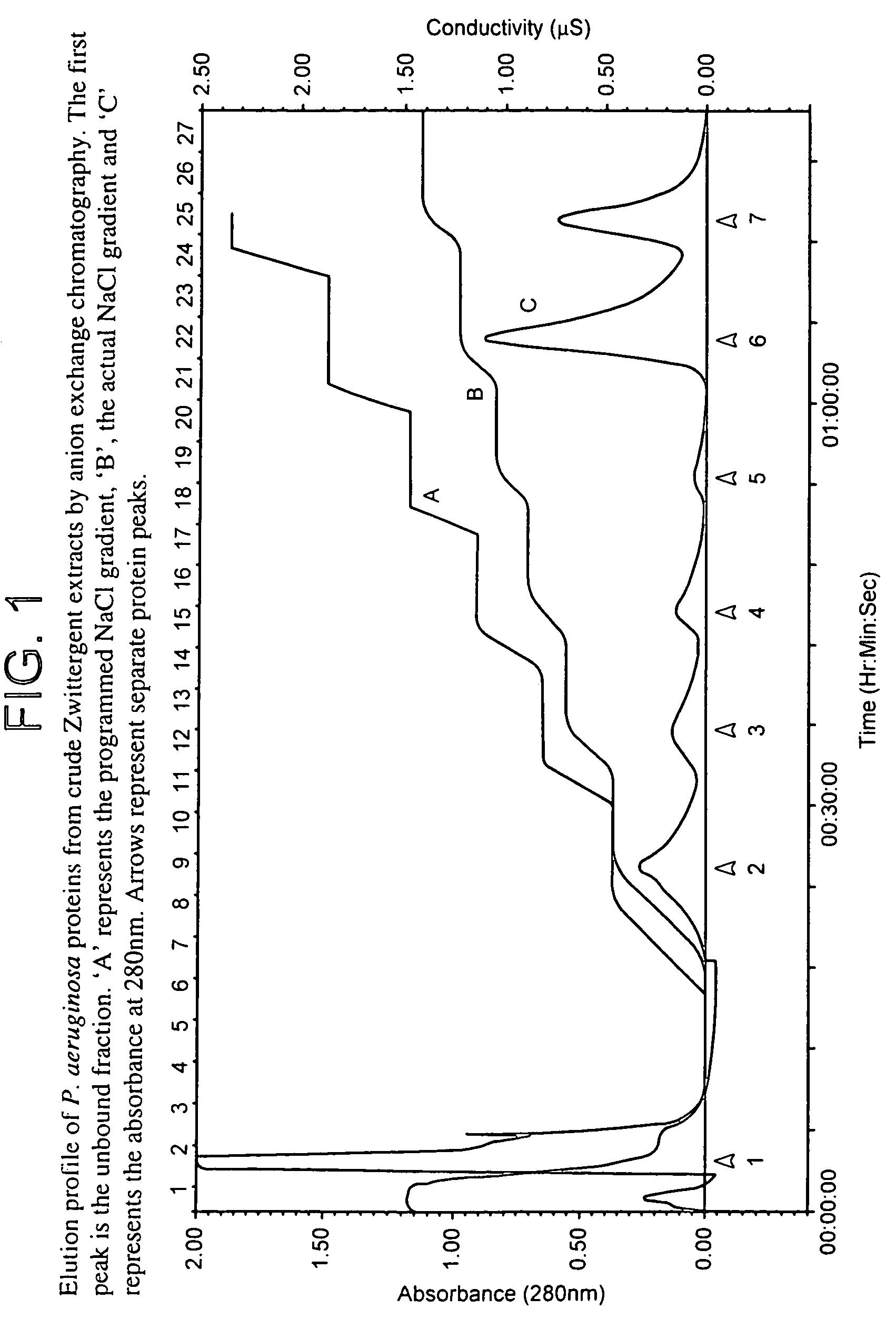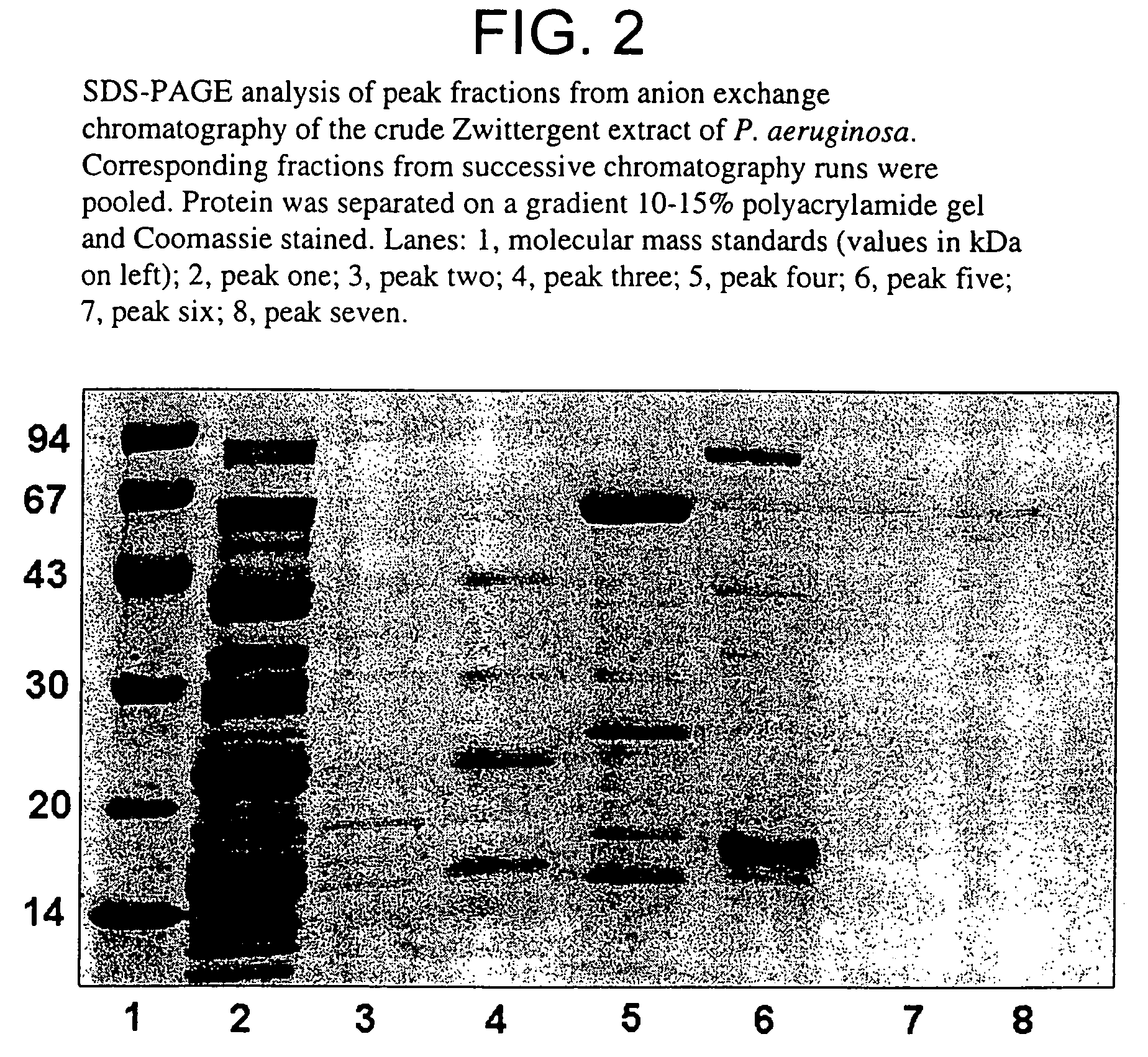Pseudomonas aeruginosa antigens
a technology of pseudomonas aeruginosa and antigens, applied in the field of antigenic proteins, can solve the problems of significant morbidity and mortality in immuno-compromised subjects, and achieve the effect of reducing the load of bacteria and reducing the clearance level
- Summary
- Abstract
- Description
- Claims
- Application Information
AI Technical Summary
Benefits of technology
Problems solved by technology
Method used
Image
Examples
example 1
Isolation of Proteins from P. aeruginosa
Bacterial Strains
[0088]The mucoid P. aeruginosa isolate Strain 385, Serotype 2 was used for the purification, for immunisation and homologous challenge. This strain was originally isolated from a chronically infected patient with cystic fibrosis. Bacterial stocks were stored at −85° C. in nutrient broth (Oxoid Unipath Ltd, Basingstoke, Hampshire, UK) and supplemented with 10% glycerol (v / v).
Bacterial Growth Conditions
[0089]Two hundred nutrient agar plates (Oxoid Unipath Ltd. Basingstoke, Hampshire, UK) were used for each extraction. Bacteria were streaked onto agar plate for lawn growth and incubated overnight at 37° C. Bacteria were harvested by scraping and washed three times by centrifugation (12000×g, 14 minutes, 4° C., Beckman Centrifuge). Following each centrifugation step, the bacterial pellet was retained and then resuspended in fresh sterile phosphate buffered saline (PBS).
Protein Purification
[0090]The washed bacterial pellet was res...
example 2
Purification of Pa80
[0105]Purification protocols to isolate quantities of protein sufficient for use in immunisation studies were developed for proteins from Pseudomonas aeruginosa. A three-stage process of Zwittergent detergent extraction, liquid column chromatography and preparative SDS-PAGE was utilised for separation. The antigen Pa80 was purified from P. aeruginosa 385 (serotype 2). SDS-PAGE confirmed the homogeneity of the purified sample. Pa80 (80 kDa) was isolated, confirmed free from the endotoxin contamination and thus suitable for investigation of its vaccine potential.
Materials and Methods
[0106]Bacteria from P. aeruginosa strain 385 (serotype 2) were used to purify Pa80 for immunisation studies. Bacteria were grown overnight, harvested, washed, and a crude detergent-extractable protein preparation was obtained as previously described (example 1). The lyophilised crude extract was resuspended in a minimal amount of distilled water and SDS-reducing buffer. Purification of ...
example 3
Sequencing of Purified Proteins
[0113]Both NH2-terminal and internal amino acid sequence analyses were carried out at the Biomolecular Resource Facility, Centre for Molecular Structure and Function, Australian National University and at the University of Liverpool U.K. for Pa80. Sequencing was carried out using the SDS-PAGE compatible S-2-carboxamidoethylation method. The alkylation reaction was performed on the protein in a solution of 10% glycerol (v / v), 5% (w / v) SDS, 0.25M Tris HCl, 100 mM 1,4-Dithiothreitol (1,4-DTT), pH 8.3. The protein was reduced initially by incubating this mixture at 90° C. for 15 minutes. The sample was then cooled to 37° C., acrylamide added to a final concentration of 3 M and the mixture incubated under argon with light excluded for 30 to 60 min. SDS reducing buffer was added, the sample subjected to SDS-PAGE, the protein was visualised by Coomassie staining and excised from the gel. Following sequence analysis, the data obtained were subjected to BLAST s...
PUM
| Property | Measurement | Unit |
|---|---|---|
| Atomic weight | aaaaa | aaaaa |
| Volume | aaaaa | aaaaa |
| Volume | aaaaa | aaaaa |
Abstract
Description
Claims
Application Information
 Login to View More
Login to View More - R&D
- Intellectual Property
- Life Sciences
- Materials
- Tech Scout
- Unparalleled Data Quality
- Higher Quality Content
- 60% Fewer Hallucinations
Browse by: Latest US Patents, China's latest patents, Technical Efficacy Thesaurus, Application Domain, Technology Topic, Popular Technical Reports.
© 2025 PatSnap. All rights reserved.Legal|Privacy policy|Modern Slavery Act Transparency Statement|Sitemap|About US| Contact US: help@patsnap.com



